|
In the nineteenth century Harriet Beecher Stowe’s Uncle Tom’s Cabin ranked as the number two global bestseller, outsold only by the Bible.
In 1852 Stowe sold 10,000
copies of her anti-slavery
novel in the United States
in its first week of its
publication, 300,000 in
the first year, and in
Great Britain, 1.5 million
copies in one year. The
book was a phenomenon, and
its author became an
international
celebrity.
The cultural impact of
Stowe’s work is the
subject a new exhibit at
the Bowdoin College Museum
of Art; it explores the
way the literary work
inspired a wide array of
visual images on both
sides of the Atlantic that
helped to shape the
complicated, often
controversial context of
Stowe’s novel. The
Book of Two Hemispheres:
Uncle Tom’s Cabin in
the United State and Europe offers a collection of more than thirty engravings, sculptures, sheet music, literary editions, and popular mass culture items like trading cards that provide glimpses into the pervasiveness imprint of Stowe’s work on the popular psyche.
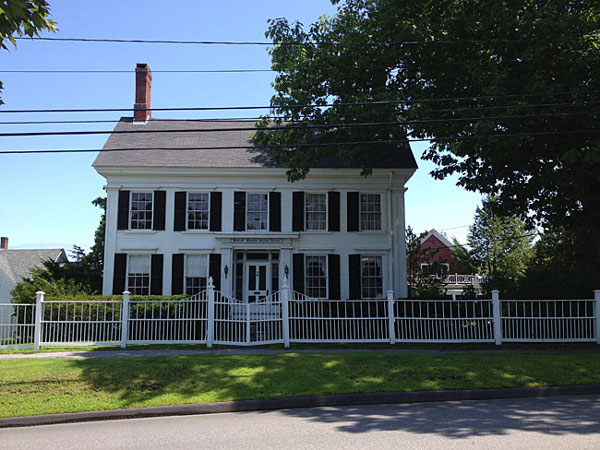
Harriet Beecher Stowe had a deep connection to the town of
Brunswick, Maine. She came there in 1850 as the wife of Calvin Stowe,
who had been appointed Professor of Divinity at his alma mater,
Bowdoin College. It was in Brunswick’s First Paris Congregational
Church, seated in the family pew 23 one Sunday, that Harriet
experienced the vision of an enslaved man’s death by beating which
prompted her to write Uncle Tom’s Cabin. Thus, the quiet Maine town
of Brunswick with its strong Abolitionist sensibilities became the
novel’s birthplace. The Stowe family - Harriet, Calvin, and six children
(her infant son had died in 1849) - lived in Brunswick for several years
in a stately house at 63 Federal Street, and when Harriet set about to
write Uncle Tom’s Cabin she rented a room in another home at 28
College Street where she could retreat from the chaos of her domestic
situation and write in relative peace.
The intellectual and cultural climate that nurtured Stowe’s novel had
deep roots in the anti-slavery movement; Brunswick served as an
important stop on the Underground Railroad, of which the Stowe
House was used as a station, and played host to fiery Abolitionists like
Henry Ward Beecher, Harriet’s brother, who delivered his sermons
from the pulpit of the First Parish Church.
But while Stowe, herself, asserted that her novel was a passionate plea
to end slavery, a plea which none other than President Abraham
Lincoln praised as a rallying cry for Emancipation, from the very first
days of the book’s publication, controversy swirled around its 266
pages. The opposition from the slaveholding South was to be
expected; Stowe’s Abolitionist stance was anathema to them. But from
the first and in an ever-growing chorus of dissatisfaction, voices were
raised in criticism of what some felt were racist overtones in the novel.
Stowe’s characters were too stereotypical; her black characters,
especially Uncle Tom, were too passive, too accepting of their cruel
fate, too eager to please those in power. Others, like Topsy were
trivialized and foolish. The spectrum of white characters did include
the hated villain Simon Legree, but it also included the saintly Little
Eva and the well-meaning plantation owner, Augustine St. Clare.
While Stowe’s narrative was fueled by her anti-slavery sentiments, it
was also deeply influenced by her Christianity and some of the
problematic depictions of character stem from this idealized vision of a
saintly, martyred enslaved hero like Uncle Tom and a belief that bonds
of affection and loyalty can exist between master and slave. This
idealized nineteenth century view of race relations, while clearly falling
short of reality, proved a powerful emotional tool that Stowe used to
move those in power – to convince the white hierarchy that
emancipation was the MORAL choice, the Christian choice, the
righteous path toward equality.
Harriet Beecher Stowe’s Uncle Tom’s Cabin did not offer solutions to
the complicated issues of race in America, yet it remains, if taken in
context, as a radical rallying cry against human enslavement. The
novel inspired countless artistic responses in its day – some exploring
the themes of freedom and equality; others aimed at a more mass
appeal that popularized characters or scenes from the novel in songs -
mass images like trading cards, logos, medallions. Suffice it to say that
Harriet Beecher Stowe was a household name, and the characters of Uncle Tom’s Cabin became part of American and European cultural
tradition.
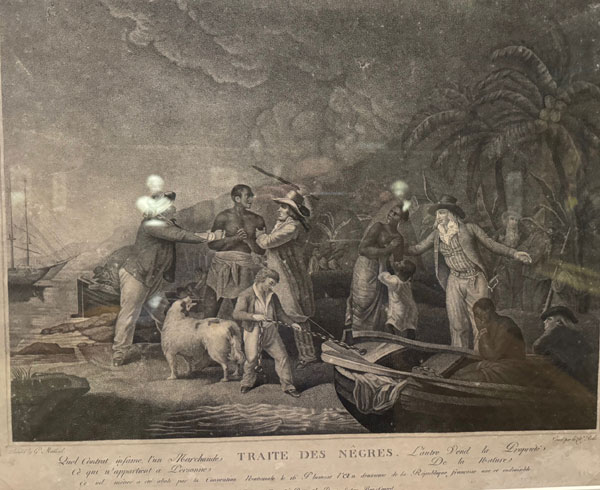
The exhibit offers a look at some of the contemporary responses to
Stowe’s work, as well as some notable European antecedents
addressing the issue of slavery. Several images predate Stowe’s novel
but illustrate the climate in which she was writing. An 1788 engraving
by Citoyenne Rollet (after The Execrable Human Traffic, a painting by
George Morland) depicts a father on the West Coast of Africa being
abducted by enslavers in front of his wife and children. The engraver,
clearly inspired by the French Revolution, adds her own caption
damning the slave trade which the French Republic abolished in 1794.
An 1808 engraving by Joseph Collyer the Younger after Henry Moses
Commemorates the abolition of the slave trade in the British-occupied
Caribbean .Allegorical figures of Britain, Justice, and Religion, as well
as a nod to William Wilberforce, who led the parliamentary effort, by
depicting his bust in the composition. This emphasis is on the role the
white British Establishment played in ending the abomination of
slavery with little credit given to grassroots resistance in the Caribbean.
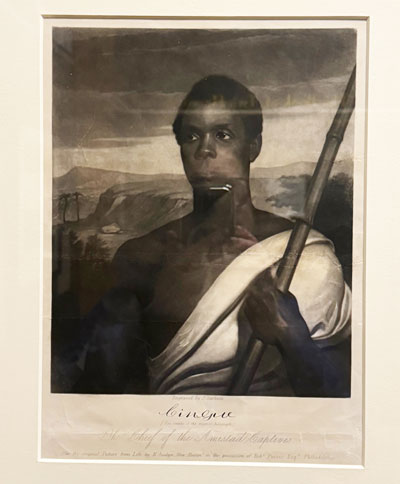
Notable, however, among these early works is John Sartan’s 1841
engraving after Nathaniel Jocelyn depicting Senghe Pieh, known by his
Europeanized name Joseph Cinque, who led a slave revolt aboard the
Spanish vessel La Amistad. When mainstream Philadelphia
newspapers attempted to suppress the image, black abolitionist Robert
commissioned the engraving to help raise support for the plight of
African captives by reaching a mass audience. The noble, imposing
portrait of Pieh is a rare image of a Black man that is nuanced and
individualized, as well as symbolic.
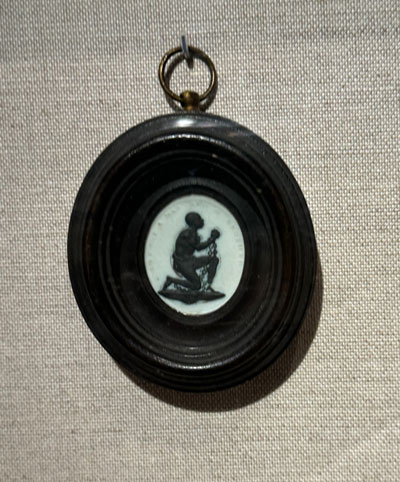
Josiah Wedgewood of pottery fame produced a medallion in 1787 for
Thomas Clarkson’s anti-slavery society advocating for the abolition of
the slave trade in Britain. The artist, William Hackwood, depicts a
mostly nude African man shackled at ankles and wrists, kneeling in
supplication with the words “Am I not a man and a brother?” inscribed
around him. The black figure on the white background makes a stark
and powerful contrast.
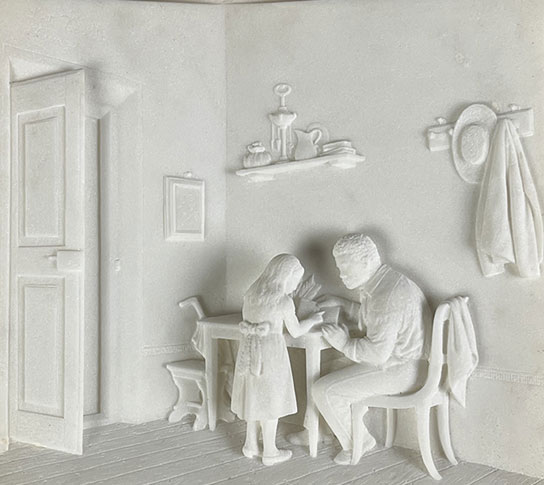
The images in the exhibition created after publication of Uncle Tom’s
Cabin are among the most affecting. There are two classical style bas
reliefs (1870), sculpted by the Italian artist Lot Torelli, who worked in
Florence and was associated with American expatriates there. One
portrays Little Eva teaching Uncle Tom to read and the other the vision
of Little Eva as an angel that appears to Tom after the child’s death.
Both key scenes from the novel, Torelli’s work uses the clean, simple
lines of Neo Classicism and the white marble which serves as a cool,
pure medium to add gravitas to the subjects.
Similar works in the Neo-Classical style are the two busts of Harriet
Beecher Stowe. The first created in 1857, when the sitter was 46 years
old, by British sculptor Susan Durant elevates Mrs. Stowe to an heroic
realm with her ivy crown, while it maintains her womanhood
-wife/mother- with the cameo of her husband which she wears. The
second, created in 1893 by Anne Whitney, shows Stowe at age 82 still
seeming remarkably untouched by time. Clearly both artists are
immortalizing the spirit of the woman in these idealized forms.
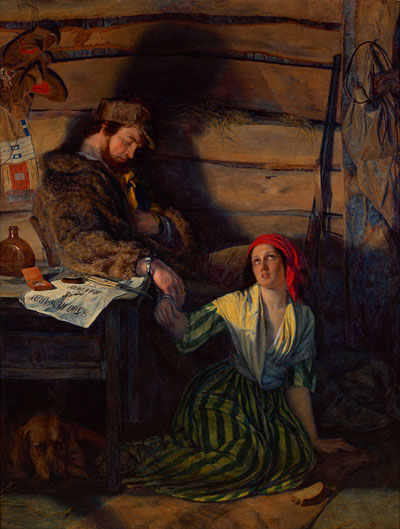
The eye-catching highlight of the exhibition is William Gale’s 1856
large scale oil painting entitled The Captured Runaway. Influenced by
European Romanticism and history painting and American genre
artists, Gale depicts a mulatto woman captured by a bounty hunter.
Her wide-eyed, beseeching gaze and supplicating pose elicits the
viewer’s sympathy. Gale’s painting, like Stowe’s novel, is a powerful
response to the 1850 Fugitive Slave Act.
Other items in the exhibit bear witness to the widespread cultural
influence of Stowe’s novel. A case contains some of the many editions
of the work including translations into French,, Spanish, Dutch.
Another British edition with illustrations influenced by caricature artist
George Cruikshank depicts the characters, especially the African
-Africans, in a stereotypical manner with exaggerated physical
features. It demonstrates how these distorted images sadly set the tone
for portraying African-Americans for many years to come in art, film,
and media.
Some works demonstrate the mass appeal of Stowe’s book and the
commercialization of her characters and themes. Two late 19th century
prints bear only a loose association to Uncle Tom’s Cabin, yet the novel
is referenced. Mrs. Stowe’s Uncle Tom at Home in Kentucky (from
Century Illustrated Magazine) reflect the post-Civil War tendency to
romanticize the Old South and make exotic the African-American
traditions there. We feel the awkward antecedents of Stephen Foster’s
songs or American minstrelsy in this take on Uncle Tom’s Cabin.
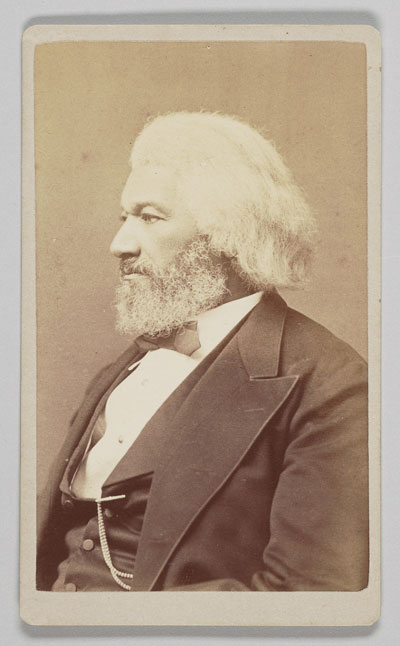
Other mass appeal images include a large collection of cartes de visite
and trading cards. An 1878 visiting card by photographer Samuel M.
Fassett of Frederick Douglass treats the subject with respect and
dignity. Its dignity and gravitas are in sharp contrast to the trading
cards with scenes from Uncle Tom’s Cabin. These cards were used to
advertise not only productions of the stage adaptation of the novel but
also minstrel plays in which Stowe’s characters, like Topsy and
Ophelia, were sometimes inserted as slapstick figures who amplified
racist stereotypes and flew directly against the grain of Stowe’s
message.
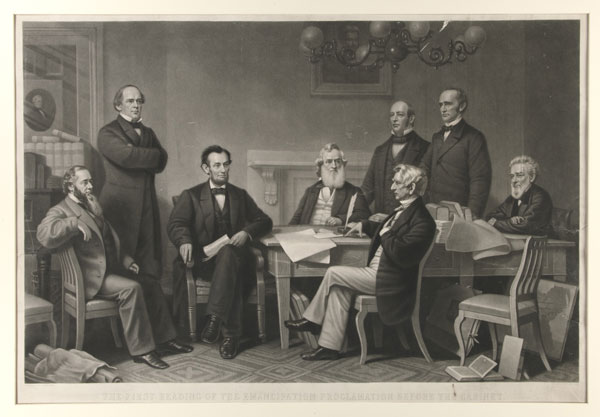
One final 1866 image, an engraving by Alexander Hay Ritchie after
Francis Bicknell Carpenter, illustrates the Emancipation Proclamation
Before the Cabinet. Formal in composition and layered with a sense of
historic nobilitas, the composition pays tribute to President Lincoln’s
achievement in navigating the perilous road to emancipation. Henry
Ward Beecher is one of the notables whose likeness appears in the
assemblage. The work in meant as a victory celebration of a goal
Harriet Beecher Stowe so passionately espoused. What is important –
and disconcerting – to note is that the work focuses on the white
statesmen involved in the watershed moment. And this focus reveals
the thought-provoking truth made visible in this exhibit.
Like Harriet Beecher Stowe’s novel, Uncle Tom’s Cabin, much of the
art and narrative surrounding the abolition of slavery in America was
created from a white perspective. This is not to diminish the
profundity of achievement Lincoln’s Emancipation Proclamation was,
nor to discredit Stowe or her Abolitionist associates for painting a
picture of America’s great evil through white eyes. But as sweeping,
powerful, far-reaching, and transformative as Stowe’s story has been,
it is an incomplete narrative. In an exhibition filled with intriguing
images, it is those who are invisible that speak the loudest.
The Book of Two Hemispheres: Uncle Tom’s Cabin in the United
States and Europe runs until June 2, 2024 at the Bowdoin College
Museum of Art, Brunswick, ME
|